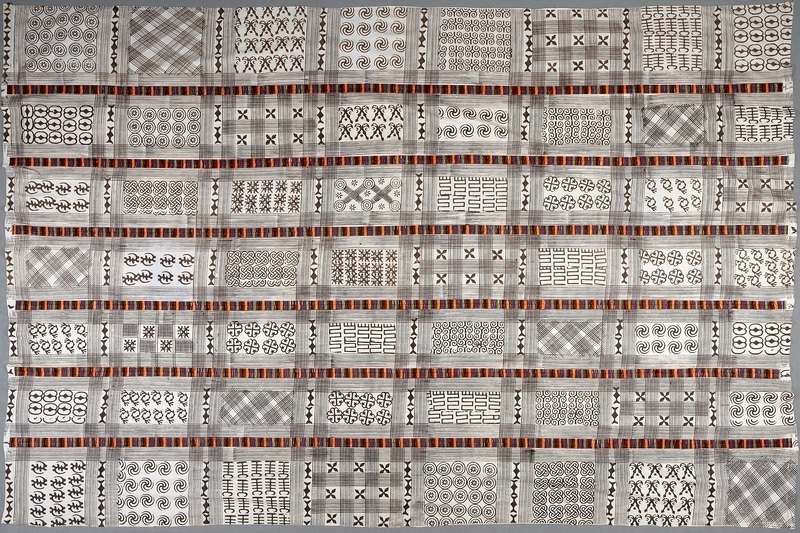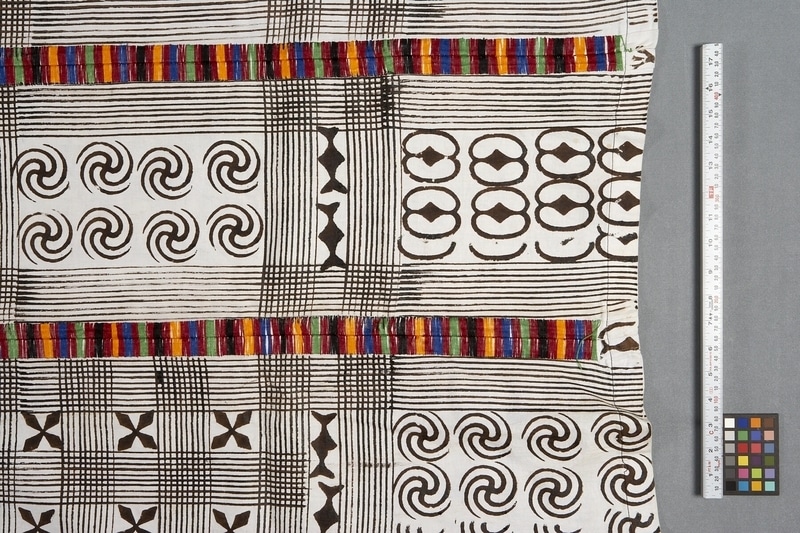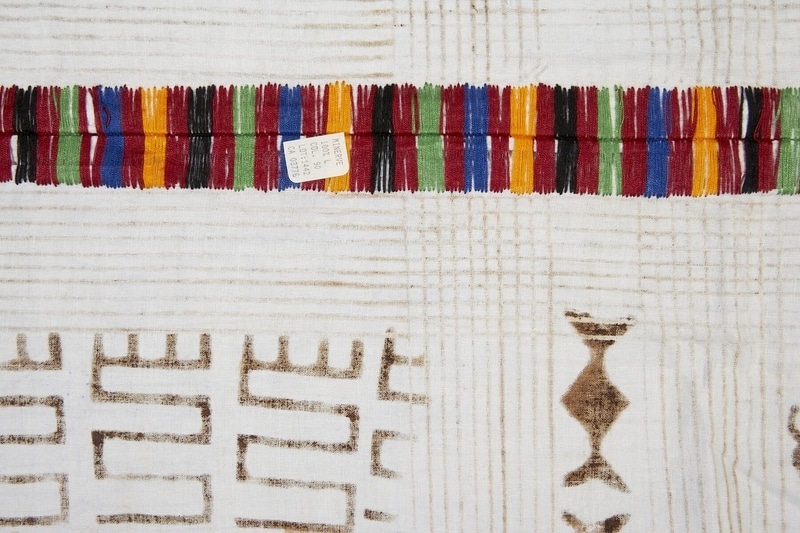Adinkra Cloth Item Number: 1774/1 from the MOA: University of British Columbia




Description
Adinkra (stamped design) cloth composed of seven strips of white cloth joined lengthwise with bands of kente weaving. Afe (comb lines) and kente divide the cloth into fifty-six squares; squares are decorated with gourd stamp patterns, as well as hatching and cross-hatching; designs done in dark brown. In between two sets of afe are ahoma/nnonoma - "double dono drums" symbols. There are two large light-blue textile company stamps on the reverse.
History Of Use
Adinkra is an ideographic communication system. Each sign represents a host of interconnected ideas, more quickly referenced by a phrase or proverb. There are over 100 signs in common use, although some carvers create a few of their own. Speaking in proverbs and illusions is a sign of prestige and refinement in Akan culture- Adinkra is a way to do this in visual form. Over the 20th century, Adinkra has become a source of pride and a marker of West African identity both in regional nationalisms (particularly Ghanaian) and in the diaspora. Fabrics adorned with Adinkra were originally associated with death, mourning, and funeral rights. Initially these were worn only by royalty and spiritual leaders with only specific cloth makers having the right to make them under the Asanti kingdom. Since gaining independence in the mid-20th century, usage in West African countries has expanded. While still considered formal wear, these textiles are no longer limited to certain social classes or specifically funerals. They are still considered nicer or formal attire. This large cloth is printed with adinkra stamps (e.g., 1774/12-16), and then embroidered.
Iconographic Meaning
The 15 Adinkra stamps used on this cloth are A. adinkra ba apau - "son of adinkrahene", B. null space or unknown symbol, C. afena/akofena - "a state ceremonial sword", D. kodee mowerewa - ”the eagle's talons”, E. dwanimen - "ram's horns", F. akoko nan tiaba na enkum - "a hen's feet are harmless to the chicks", G. ako-ben - "war horn", H. nyama, biribi wo soro, ma no me ka me nsa - "God there is something in heaven, pray let me reach it", I. gye nyame - "I fear only God", J. kramo bone amm yanhu kramo pa - "we can no longer tell fake/bad Muslims from real/good ones" or "knot of wisdom", K. funtunfunefu Denkyemfunetu - "crossed [or conjoined] crocodiles sharing one stomach", L. fofoo - "what the fofoo plant wants is that the gyantwi seeds should turn black" or ananse "spider", M. nkyimkyim - "twistings/changing oneself", N. nyame dua "God's tree" or "Altar of God", and O. obi nkaa bi - "do not bite each other without cause, avoid conflict". From top to bottom, left to right, the patterns are: row 1- A, B, C, D, E, F, G, H; row 2- H, A, F, C, D, E, B, G; row 3- I, J, K, A and L, M, N, O, G; row 4- B, I, J, K, F, M, N, O; row 5- O, K, N, M, E, B, D, H; row 6- H, O, B, N, M, E, F, D; and row 7: I, D, G, E, A, J, C, B.
Specific Techniques
A bolt of cotton is laid upon a length of foam on top of a wooden board. Rocks followed by small nails are placed along the fabric to hold it in place and keep the fabric taut. A comb is dipped into the ink and then pulled across the fabric to demarcate areas to be printed. Stamps are chosen by the stamper or the person who has commissioned the piece. Most often one area contains repetitions of one symbol, but a small number can be selected in to repeat. The stamp is then dipped in ink, with excess shaken off away from the fabric. The stamp is rocked gently from one edge to the other for each press to the fabric. The stamp is redipped into the ink before each reapplication. Kente strips are sometimes sewn in between strips or swathes of Adinkra printed cloth.
Item History
- Made in Ghana before 1960
- Collected during 1960
- Owned by Penny Gouldstone
- Owned by Brian Gouldstone before November 10, 1998
- Received from Brian Gouldstone (Donor) on November 10, 1998
What
- Name
- Adinkra Cloth
- Identification Number
- 1774/1
- Type of Item
- cloth
- Material
- cotton fibre, ink ? and dye
- Overall
- height 227.0 cm, width 330.0 cm
Who
- Culture
- Asante
- Previous Owner
- Penny Gouldstone and Brian Gouldstone
- Received from
- Brian Gouldstone (Donor)
Where
- Holding Institution
- MOA: University of British Columbia
- Made in
- Ghana
When
- Creation Date
- before 1960
- Collection Date
- during 1960
- Ownership Date
- before November 10, 1998
- Acquisition Date
- on November 10, 1998
Other
- Item Classes
- textiles
- Condition
- good
- Current Location
- Case 98
- Accession Number
- 1774/0001